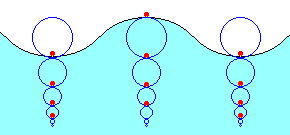Classification of Sea Waves.
Waves / wave that occurred in the sea can be classified into several types depending on generator power.
Sea wave generator can be caused by: wind (wind waves), sun-moon gravitational pull-earth (tidal waves), seismic (volcanic or tectonic) on the seabed (the tsunami), or waves caused by movement of the ship.
Waves that occur daily and taken into account in the field of coastal engineering is the wave of wind and tides (tidal).
The wave energy would create currents and influence the movement of sediment in the direction perpendicular to the beach (cross-shore) and parallel to the shore (along the coast). The technical planning of coastal engineering, wave is the main factor taken into account, since it would cause forces on coastal structures.
What is a Wave of the Sea?
These waves are rising and falling of water movement in the direction perpendicular to the surface of the sea water that forms a curve / graph sinusoidal. sea waves caused by wind.
Winds over the ocean to transfer energy to the waters, causing ripples, city / hill, and turned into what we call a wave. In the field of oceanography, Waves is known as a wave in the (internal wave). This phenomenon also exists in the field of meteorology, where the wave propagates at the interface layer between the warm and cold air. Meteorologists have become more involved with the liquid in the form of atmospheric gases, whereas oceanography experts more involved with the liquid in the form of liquid water ocean.
Mechanism of Occurrence of Sea Waves.
Observe the motion of buoys in the animated picture above the waves. Note that the actual buoy moves in a circle (orbital) when the wave moves up and down. Particles of water in one place, moving in circles, up and down with little movement from side to side behind the original. This movement represents a wave. Buoy floats on the water moved into the same pattern, up and down in a slow circle, which is carried by water movement.
Beneath the surface, the rotary motion wave has narrowed. There are shrinking along with the orbital motion of water depth, so that later on will only leave a small horizontal movement from side to side so-called "surge".
Traveling wave motion wave height and period length his generation coast brings. Search is the journey the distance from the initial wave of his generation. Fetch is limited by the shape of the earth around the sea. The longest is the distance from its height of wave brings, it will be even greater.
Wind also has an important influence on wave height. stronger wind will produce larger waves. Wave that spreads from the deep ocean (water) toward the coast will experience a change in shape due to changes in deep water.
If the wave moves toward shore, the movement of waves at the bottom of the seabed adjacent to slow down. This is the result of friction / friction between water and shore base.
Meanwhile, the top of the waves on the surface of the water will go. More and headed to the beach, the waves will be more sharp peaks and valleys will be more flat. The phenomenon that causes the wave is then broken.















0 Comments:
Post a Comment